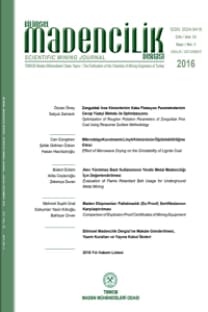ASİDİK MADEN DRENAJININ (AMD) GİDERİLMESİNDE UYGULANAN BİYOLOJİK YÖNTEMLER
Asidik maden drenajı (AMD), dünyanın her yerinde madencilik alanlarında önemli bir çevresel
problemdir. Sülfürlü minerallerin madencilik alanlarında depolanması ve atılması sürecinde su ve
oksijene maruz bırakılması sonrasında, bu tür minerallerin doğal oksidasyonunun bir sonucu olarak
AMD meydana gelmektedir. Asidik Maden Drenajının düşük pH ve yüksek derişimlerde çözünmüş
metal ve sülfatları içermesi nedeniyle çevreye potansiyel olarak zarar verebilmektedir. Eğer AMD’nın
oluşumu önlenemez veya kontrol edilemezse; toplanmalı, çevreye bırakılmadan önce ağır metal
konsantrasyonu ve askıda katı madde miktarını azaltmak ve asitliğini bertaraf etmek için muamele
edilmelidir. AMD’nın giderilmesinde farklı tipteki mikroorganizmalar; mikrobiyolojik önleme, kontrol ve
giderim teknolojilerinin uygulanmasında ve gelişmesinde çok önemli bir rol oynayabilmektedir. Bu
makalenin amacı, AMD’nın kontrolü ve gideriminde kullanılan pasif biyolojik yöntemler ve bu
yöntemlerdeki mikroorganizmanın rolü ile ilgili bilgi vermektir.
Anahtar Kelimeler:
Asidik Maden Drenajı, Çevre, Sülfürlü Cevherler, Biyoteknoloji
Biological Methods Applied in the Treatment of Acid Mine Drainage (AMD)
Acidic mine drainage (AMD) is a serious environmental problem in mining areas throughout the world.
AMD occurs as a result of the natural oxidation of sulfide minerals when they are exposed to oxygen
and water during their disposal and storage at the mining areas. Because it includes low pH and high
concentrations of dissolved metals and sulphates, AMD can potentially damage to the environment.
If the formation of AMD can’t be prevented and controlled, it must be collected and treated to remove
acidity and reduce the concentration of heavy metals and suspended solids before its release to the
environment. Different types of microorganisms in the treatment of AMD can play a very important role
in the development and the application of microbiological prevention, control and treatment
technologies. The purpose of this article is to give information about the passive biological methods
used in the treatment and the control of AMD and the role of microorganisms in these methods
Keywords:
Acidic Mine Drainage, Environment, Sulphide Ores, Biotechnology,
- ISSN: 2564-7024
- Yayın Aralığı: Yılda 4 Sayı
- Yayıncı: TMMOB Maden Mühendisleri Odası
Sayıdaki Diğer Makaleler
ASİDİK MADEN DRENAJININ (AMD) GİDERİLMESİNDE UYGULANAN BİYOLOJİK YÖNTEMLER
HAVZA JEOTERMAL SAHASINDA YAPILAN SH-5 VE DİĞER SONDAJLARIN GENEL DEĞERLENDİRMESİ
MADEN ATIKLARI İLE İLGİLİ MEVZUAT : AVRUPA BİRLİĞİ VE TÜRKİYE
Emel Güney ÇETİNER, Bahtiyar ÜNVER, Mehmet Ali HİNDİSTAN
KİREÇ SÖNDÜRME ŞARTLARININ SÖNDÜRÜLMÜŞ KİREÇ KALİTESİNE ETKİSİ
